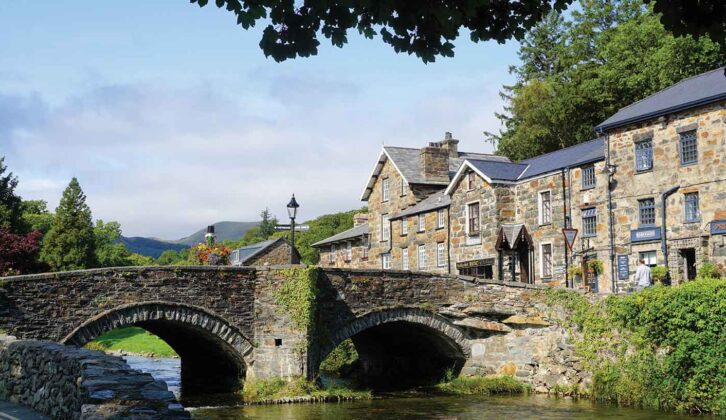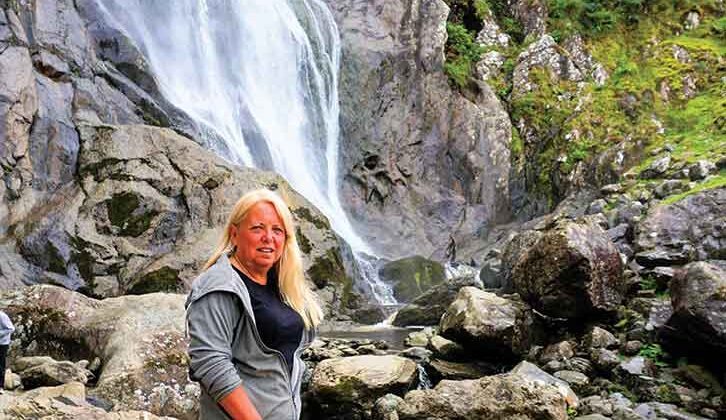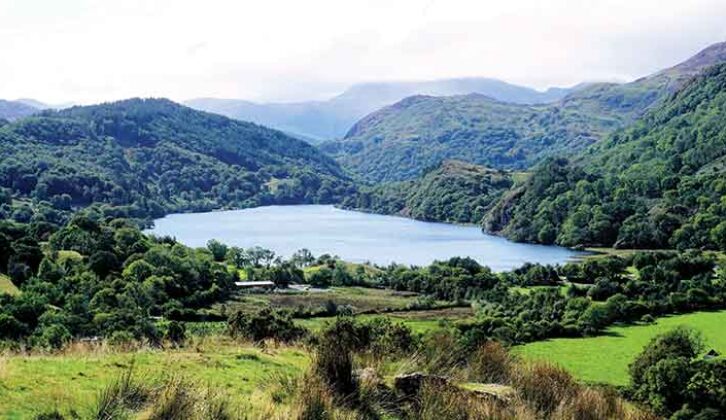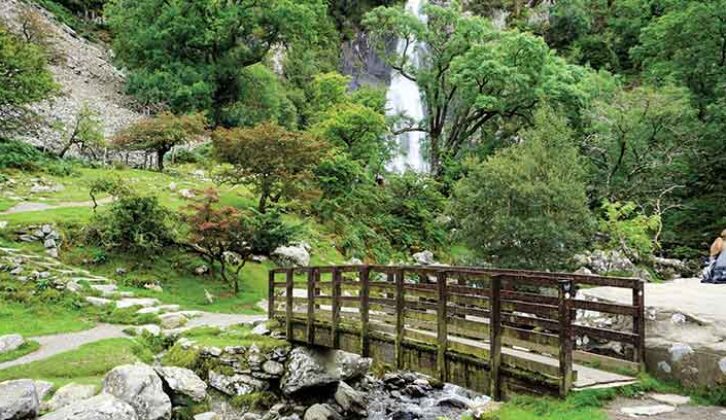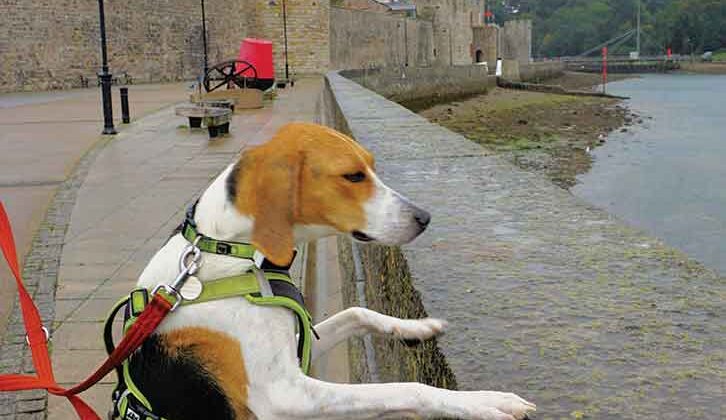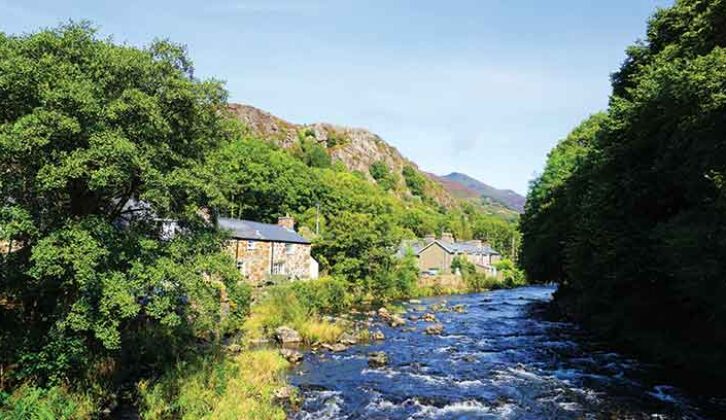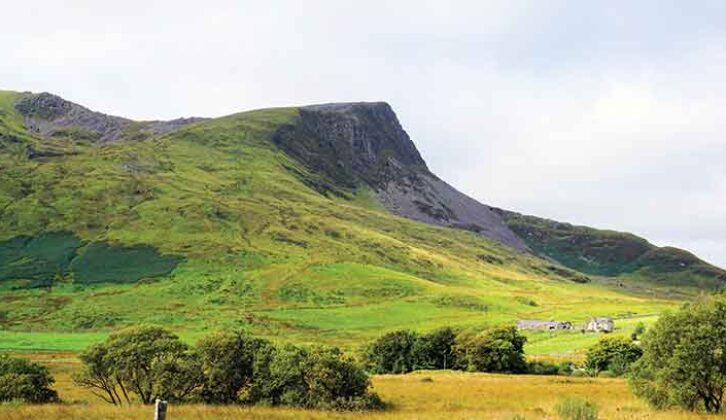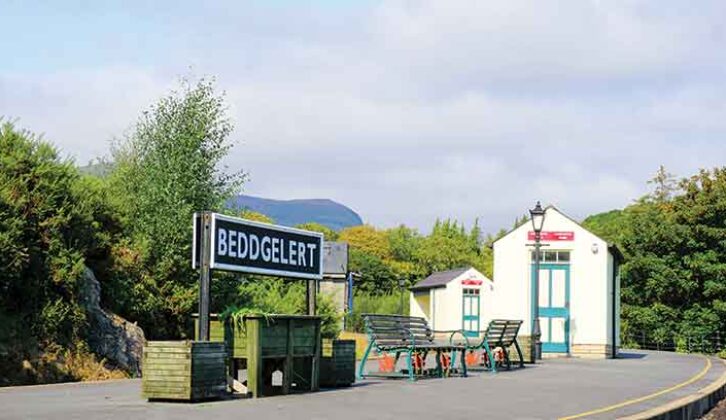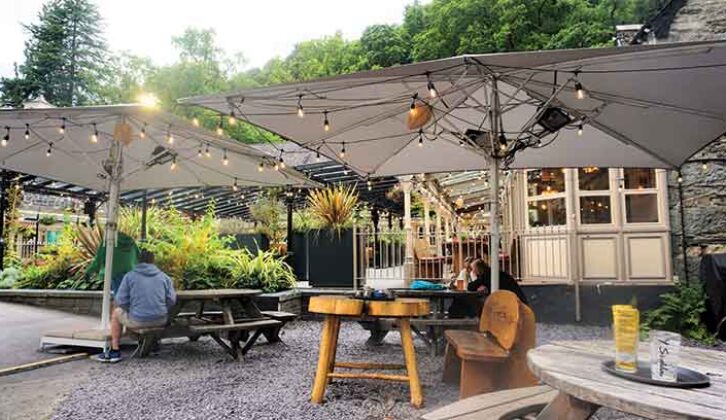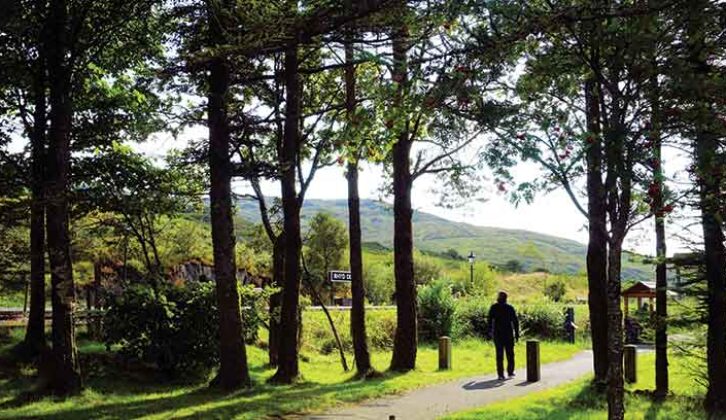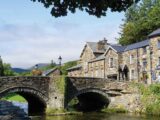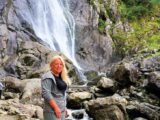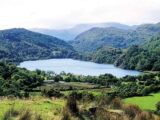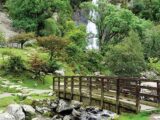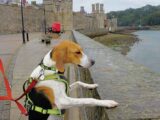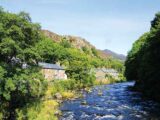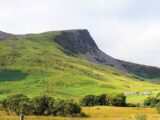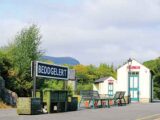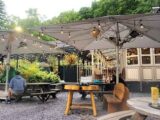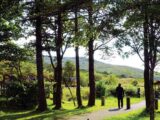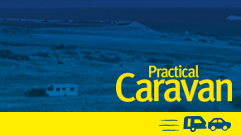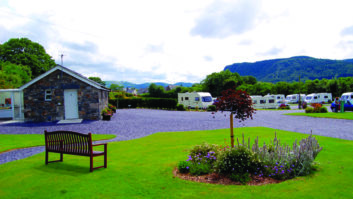Wales is famously a land of castles – not only those built of stone which have stood the test of time, but also of far more temporary constructions, made of sand and washed away by the rippling tide.
On a recent visit to its spectacularly beautiful north, I also discovered that Wales is a land of water (and of railways, but that’s a story for another day) – from the sea demolishing those sandy structures, to the moats surrounding castles of stone, and from the gently meandering rivers to the wildly cascading waterfalls.
If you’re thinking of embarking on a tour of this stunning area, be sure to check out our best caravan park in Wales guide.
Caernarfon cobbles
We started our trip at the small but friendly Is-Helen Farm Caravan Park in Caernarfon, a convenient 20-minute walk from town via the Aber Swing Bridge (whose gates are locked at 11pm prompt, no exceptions) over the first of the several rivers that we encountered – the Seiont – which brings you right up to the doors of one of those hugely impressive castles.
Despite the persistent rain (yes, Wales is definitely a land of water!), we were keen to get our first taste of Caernarfon, so quickly settled on our pitch, donned waterproofs and set off to explore.
A bustling market town with narrow cobbled streets, built around a natural harbour, Caernarfon has splendid views over the mighty Menai Strait.
Standing admiring this view, I could imagine it on a warm summer day, with seagulls wheeling overhead and children crabbing or eating ice cream.
Today it was just damp! But nevertheless, we spent a happy afternoon wandering around the streets, shops and castle.
One of Edward I’s Iron Ring of castles (which have UNESCO World Heritage status), Caernarfon Castle was built around 1283. Having an ideal location overlooking land and sea, it was intended as a home for the Prince of Wales – Edward’s son, the first Prince of Wales, was born here.
Today, it remains the site of investiture ceremonies for each new Prince of Wales. Charles’s kneeling stool and Elizabeth II’s throne are on display in the Chamberlain Tower, while the Queen’s Tower houses the Museum of the Royal Welch Fusiliers.
We found more history when we stopped for liquid refreshment. Thought to date from 1522, the Black Boy Inn is one of the oldest hostelries in North Wales, with walls over a metre thick in places, and beamed ceilings. No dogs are allowed in the main building, but we (including our dog) were already wet, so we didn’t mind sheltering under a brolly in the beer garden while we indulged in a real ale (made with Welsh water!).
For more sightseeing opportunities, the heritage Welsh Highland Railway connects Caernarfon with Porthmadog.
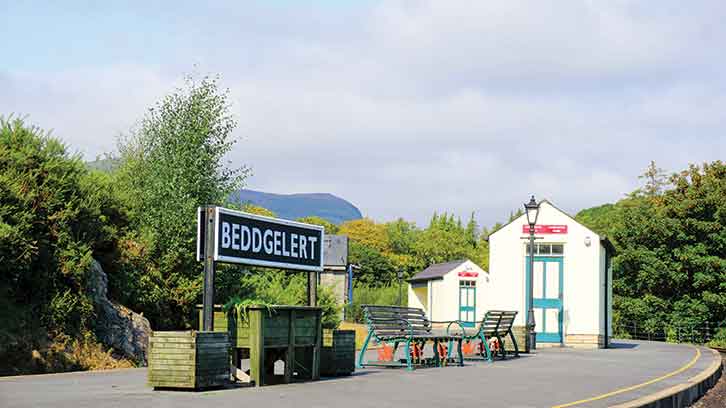
Alternatively, the Ffestiniog Railway will take you to Beddgelert, but we were wet and weary, and retreated to the warmth of our van to dry off and plan the next day’s outing over dinner. There is so much to see and do in this part of the world, we knew we wouldn’t be able to fit it all in, so we had some tough choices to make.
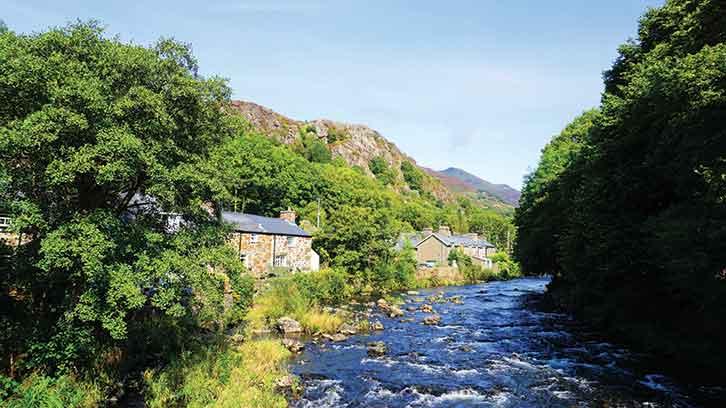
For starters, there are many gorgeous beaches within reach, but for now they were off our itinerary – better to save them for another, sunnier, time. Then there are all of those castles, towns and villages to choose from. In the end, we decided to go for Conwy, which also gave us another of Edward’s castles to explore, and at the other end of the scale, the Smallest House in Great Britain, aka Quay House. In this intriguing building that’s just six feet wide, the front door is positively tiny.
With its cobbled streets and town walls (watch for steep steps in places), Conwy is a medieval delight and although we didn’t have time to take a boat trip or explore the beaches (next time!), we had a great day out. It included an excellent lunch at The Mulberry, on the marina, strolling around the harbour and chatting to a local honey producer in the street market, which was in full swing when we arrived.
Two days of exploring had left us rather weary, so we opted for another evening ‘at home’ with a warming casserole, a bottle of red wine and a game of Uno before bed.
Anglesey calling
One of the reasons for basing ourselves at Caernarfon was to venture onto the nearby isle of Anglesey; so next morning, no more waiting for the rain to stop, it was time to drive across Robert Stephenson’s Britannia Bridge to the historic island.
After a quick toilet stop (essential for Willow, our four-legged friend) overlooking a stretch of the Menai Strait, we headed to Beaumaris. It seems we were still following Edward’s footsteps – here is yet another of his fortifications, this one intriguingly known as ‘the greatest castle never built’.
Its unfinished yet imposing medieval architecture intermingles with Edwardian, Georgian and Victorian buildings in this charming seaside town.
The pleasant seafront is lined with pastel-coloured houses on one side and a sand and shingle beach on the other.
Huddled in our waterproofs, we explored the shops and the pier, before stopping off for a lunch of ham, eggs and chips, at the dog-friendly and welcoming Liverpool Arms.
Having spent more time here than planned, it was time to move on. Driving along the coast heading north, we passed many fine beaches, including Benllech and Amlwch (Anglesey is awash with places to spend a – drier – day building sandcastles at the water’s edge), before stopping at Porth Llechog, also known as Bull Bay.
Glad to have wellies with us, and happy to see an almost deserted beach to explore, we enjoyed splashing about on the shore and in the rockpools before having a quick stroll around Cemaes Bay, a charming spot whose main claim to fame is being the most northerly village in Wales.
We had planned to drive the full circle around Anglesey, but after spending all that time in Beaumaris, and being thoroughly soaked by the constant drizzle, we decided to save the rest of this attractive island for another trip, deeming it a most fitting place to spend a few lazy days in summer. So we turned our wheels once more towards the bridge and the mainland.
Back at Is-Helen that evening, the rain finally stopped, so we walked into town to watch the sunset (I never can resist a sunset…) from the comfort of the Anglesey Arms (… or an excuse for a G&T!).
We also wanted to visit Doc Fictoria, aka Victoria Dock, Caernarfon’s redeveloped waterfront, which we had read about before our journey. This lively part of town harks back to the days of the working harbour, and now houses a creative arts centre, café and bar, cinema and restaurants.
The trail to Aber Falls
On our final day at Is-Helen Farm, the sun graced us with its presence, so we took the opportunity to visit waters of a different kind, away from the sea, and headed to Aber Falls for a walk in the countryside.
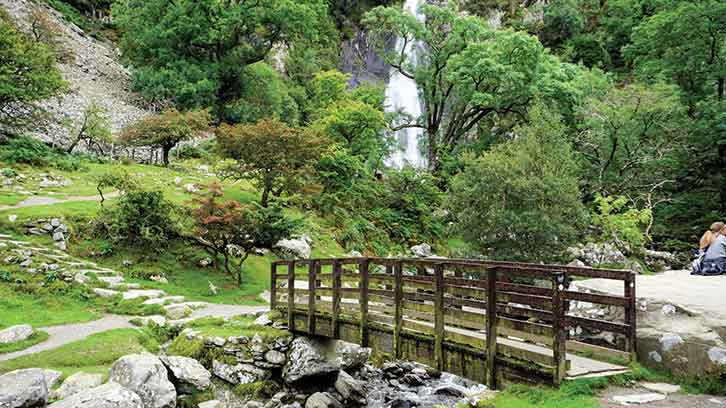
There is a car park close to the falls, but the approach road is single-track in places and we were concerned it might be busy (plus we fancied a stroll), so we parked just outside the village of Abergwyngregyn.
This added a pleasant mile to our walk and allowed us to stop at a village café on the way back, for a traditional Welsh rarebit (when in Wales!) – another dog-friendly establishment, where Willow was happy to be given a sausage by the owner.
The walk to the falls is pretty, gentle and accessible most of the way, although there are some more demanding routes in the surrounding countryside if you prefer.
There are plenty of opportunities to stop and picnic, but I imagine it gets rather busy during the summer months. That day, we had a perfect afternoon stroll, surrounded by lovely views made even better by the welcome autumn sunshine.
Mountain views
Then it was time for us to leave the coast and head inland. Our second base was Riverside Touring Park in Betws-y-Coed – a five-minute stroll along another river (and past a graveyard!) or over the railway bridge to the centre of town.
The site was less than an hour’s drive from Caernarfon, so after pitching up we decided to take in Rhyd-Ddu, one of the starting points for walks to the summit of Snowdon and a station on the Welsh Highland Railway.
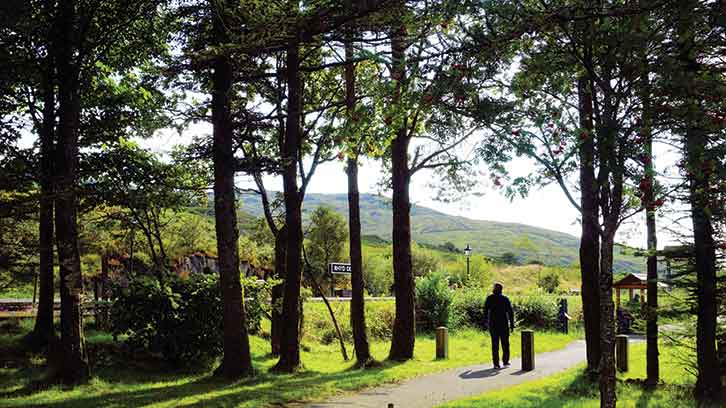
Although we love walking, climbing the mountain would have been a step too far for us these days, so we contented ourselves with admiring the breathtaking landscape from ground level before continuing on to take a look at Beddgelert village.
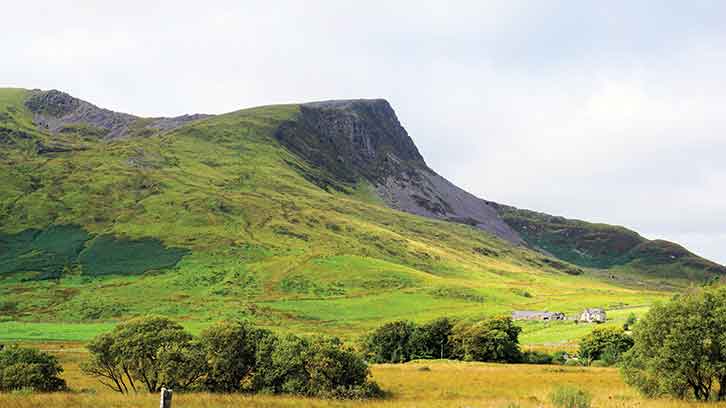
The drive itself, although short, took us through some of the most beautiful and varied scenery to be found in Wales, from majestic mountains to crystal-clear lakes.
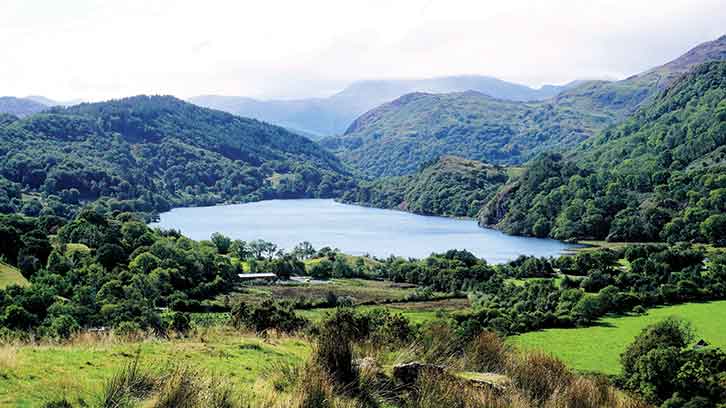
Beddgelert is now added to our list of places worth a longer stay – surrounded by all that fantastic natural beauty and with two rivers meeting in the village, this is a perfect base for enjoying the great outdoors.
It also has a train station on the Welsh Highland Railway (the views during a steam train journey must be spectacular) and a historic copper mine to delve into, as well as a couple of friendly-looking pubs and cafés. However, we decided not to stop, but drove back to the site that would be our home for the next few nights.
Woodland walk
We arrived back at Riverside Touring Park late that afternoon, tired but happy, and ready to rest up for a couple of days.
The Welsh word Coed means wood and the pretty village of Betws-y-Coed is indeed surrounded by woodland, intersected by rivers, making for a scenic location and a lovely contrast to the coast we’d just left.
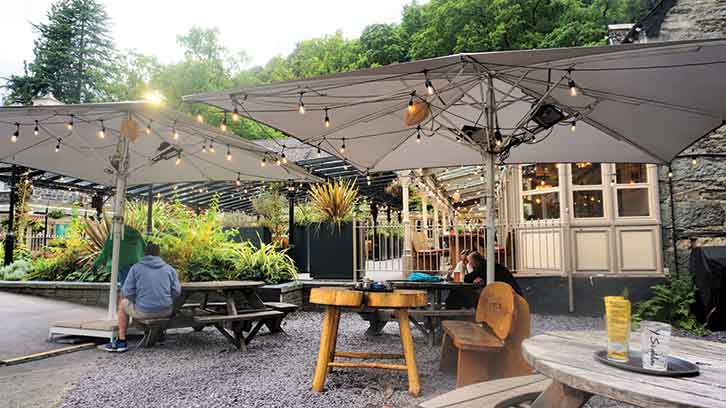
With interesting gift, craft and outdoor shops to wander around, as well as the Conwy Valley Railway Museum and Pont-y-Pair bridge (built in 1468), there was plenty to occupy us around town the following day.
Having passed the Y Stablau restaurant several times and noticed the tables were always occupied, we decided to try it for dinner. We weren’t disappointed, either – the local Welsh steak pies were delicious, and Willow was made welcome indoors as the day turned into evening.
Snowdonia National Park offers plenty of opportunities for adventure, from zipwires to mountain biking, dryland tobogganing to exploring underground, but next day, we were happy simply to stretch our legs on a scenic woodland walk.
With 14 forest trails, we were spoilt for choice, opting for a route beside the river (more of that Welsh water!) and along a section of the 83-mile Snowdonia Slate Trail, which starts and finishes at Bangor.

Good choice, as we were treated to the fleeting sight of a gorgeous kingfisher, and a much longer encounter with an elegant heron waiting patiently for his lunch.
Back in town later, we stopped for a drink at Y Stablau, before enjoying pizza and beer (and more sausage for Willow) at Hangin’ Pizzeria. Family-run and focused on sustainability and conservation work, their dishes are all palm oil free.
Next morning, we partook of a fortifying breakfast at the Conwy Falls Café, only five minutes from the campsite. From the café, you can walk among ancient woods in a Site of Special Scientific Interest to the waterfall, but for us, it was time to start for home.
This corner of Britain is small, but it is beautiful, diverse and packed with interest. We barely scratched the surface and can’t wait to return and explore further.
You can also see how I got on when I embarked on a tour to discover the delights of Suffolk.
Planning a trip to Caernarfon
When to go
We toured in early September 2022, to enjoy the autumn sun, but do take your waterproofs!
Food and drink
- Black Boy Inn, Caernarfon
- The Mulberry, Conwy
- Liverpool Arms, Beaumaris
- Anglesey Arms
- Y Stablau, Betws-y-Coed
- Hangin’ Pizzeria, Betws-y-Coed
- Conwy Falls Café
Find out more
- Caernarfon
- Caernarfon Castle
- Conwy
- Anglesey
- Aber Falls
- Snowdonia National Park
- Betws-y-Coed
- Snowdonia Slate Trail
- Welsh Highland Railway
Where we stayed
Caernarfon LL54 5RN, 01286 678 497
- Open: 1 March to 31 October
- Pitches: 16
- Price: From £25
Old Church Road, Betws-y-Coed LL24 0AL, 01690 710 310
- Open: 17 February to 3 January
- Pitches: 59
- Price: From £27.50
If you’ve enjoyed reading this article, why not get the latest news, reviews and features delivered direct to your door or inbox every month. Take advantage of our brilliant Practical Caravan magazine SUBSCRIBERS’ OFFER and SIGN UP TO OUR NEWSLETTER for regular weekly updates on all things caravan related.
